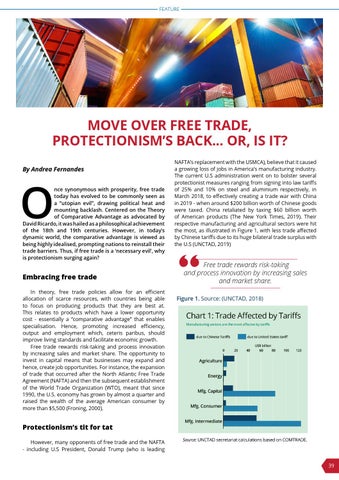FEATURE
MOVE OVER FREE TRADE, PROTECTIONISM’S BACK... OR, IS IT? By Andrea Fernandes
O
nce synonymous with prosperity, free trade today has evolved to be commonly seen as a “utopian evil”, drawing political heat and mounting backlash. Centered on the Theory of Comparative Advantage as advocated by David Ricardo, it was hailed as a philosophical achievement of the 18th and 19th centuries. However, in today’s dynamic world, the comparative advantage is viewed as being highly idealised, prompting nations to reinstall their trade barriers. Thus, if free trade is a ‘necessary evil’, why is protectionism surging again?
Embracing free trade In theory, free trade policies allow for an efficient allocation of scarce resources, with countries being able to focus on producing products that they are best at. This relates to products which have a lower opportunity cost - essentially a “comparative advantage” that enables specialisation. Hence, promoting increased efficiency, output and employment which, ceteris paribus, should improve living standards and facilitate economic growth. Free trade rewards risk-taking and process innovation by increasing sales and market share. The opportunity to invest in capital means that businesses may expand and hence, create job opportunities. For instance, the expansion of trade that occurred after the North Atlantic Free Trade Agreement (NAFTA) and then the subsequent establishment of the World Trade Organization (WTO), meant that since 1990, the U.S. economy has grown by almost a quarter and raised the wealth of the average American consumer by more than $5,500 (Froning, 2000).
NAFTA’s replacement with the USMCA), believe that it caused a growing loss of jobs in America’s manufacturing industry. The current U.S administration went on to bolster several protectionist measures ranging from signing into law tariffs of 25% and 10% on steel and aluminium respectively, in March 2018, to effectively creating a trade war with China in 2019 - when around $200 billion worth of Chinese goods were taxed. China retaliated by taxing $60 billion worth of American products (The New York Times, 2019). Their respective manufacturing and agricultural sectors were hit the most, as illustrated in Figure 1, with less trade affected by Chinese tariffs due to its huge bilateral trade surplus with the U.S (UNCTAD, 2019)
Free trade rewards risk-taking and process innovation by increasing sales and market share. Figure 1. Source: (UNCTAD, 2018)
Protectionism’s tit for tat However, many opponents of free trade and the NAFTA - including U.S President, Donald Trump (who is leading 39
